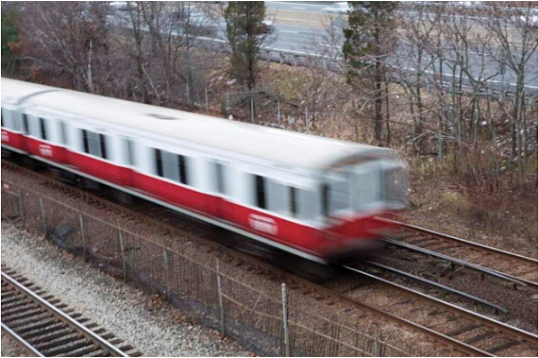January 24, 2025

A Red Line train on an approach to a station on the Braintree line. Jesse Costa/WBUR photo
With massive patches of slow zones now mostly repaired, MBTA officials have set their sights on pushing some subway speeds to even higher levels as one of the next major goals.
T officials hinted Thursday that parts of the Red Line might soon be able to accommodate travel up to 50 miles per hour, a 10 mph increase over current levels that would bring the line closer to originally designed speeds and further trim travel time for commuters.
MBTA General Manager Phil Eng said that improvement is "right around the corner," and Jody Ray, the agency's senior director of maintenance of way, said it could happen "within days."
On a chunk of the Orange Line, Eng said he wants to achieve train speeds of up to 55 mph. Boosting speeds significantly is less feasible on the Green Line due to the "geometries" of the tracks and the higher number of stops.
"But where we can and it makes sense and it's safe for the operators, we're going to do that as well," Eng said about further boosting speeds. "Where we can shave minutes off of the commutes, that's going to go hand in hand as we increase the number of trains that we run. That is our ultimate goal, not just to get to where we are today with five-minute [headways], I think, on Red, six-minute [headways] on Orange and four-minute [headways] on Blue during the peaks, but how do we start to improve off-peaks, weekends and have more trips during the day?"
Ray said the Red Line was designed to run at 50 mph between the JFK/UMass station and Braintree station, but that officials a couple of decades ago decided to set a systemwide maximum speed of 40 mph.
The T will need to get the all-clear from regulators at the state Department of Public Utilities and Federal Transit Administration to boost speeds back up, but Ray said his "comfort level is there, that tracks are in very, very good condition."
The agency, which faces a major operating budget deficit in the upcoming fiscal year, spent hundreds of millions of dollars over the past year on a sweeping repair campaign to fix track defects that blanketed miles of the system with slow zones.
That effort has proved mostly successful, decreasing travel times. Eng said Thursday that ridership is up, too, increasing 8% from December 2023 to December 2024.
The GM previously identified signals, power equipment and trains themselves as the next big goal for infrastructure work as the T chips away at the nearly $25 billion price tag to achieve a state of good repair.
Some issues still emerge. MBTA Chief Safety Officer Timothy Lesniak told the T board about an incident that occurred Monday, when one Red Line train approaching Davis Station northbound could not make it up a hill due to a "propulsion issue."
Workers moved to attach another train to "shove the disabled train up the hill," Lesniak said, but mechanical brakes failed to hold the first train in place and it rolled downhill, striking the other vehicle.
Lesniak said no one was injured in the incident, but passengers were evacuated "for a two-minute walk to the station down the tracks." Officials changed rules governing train air brakes in response to the incident.
Eng and his deputies won heaps of praise Thursday from the MBTA Board of Directors.
"Phil, when you decided to take this job, I thought you probably should have your head examined," said Quincy Mayor Thomas Koch, a member of the board. "But when I look back at the incredible progress that has been made — and I certainly tip my hat to Governor [Maura] Healey, she selected you and it was the right choice — the work you have done, that your teams have done, has brought great credibility back at the MBTA."


